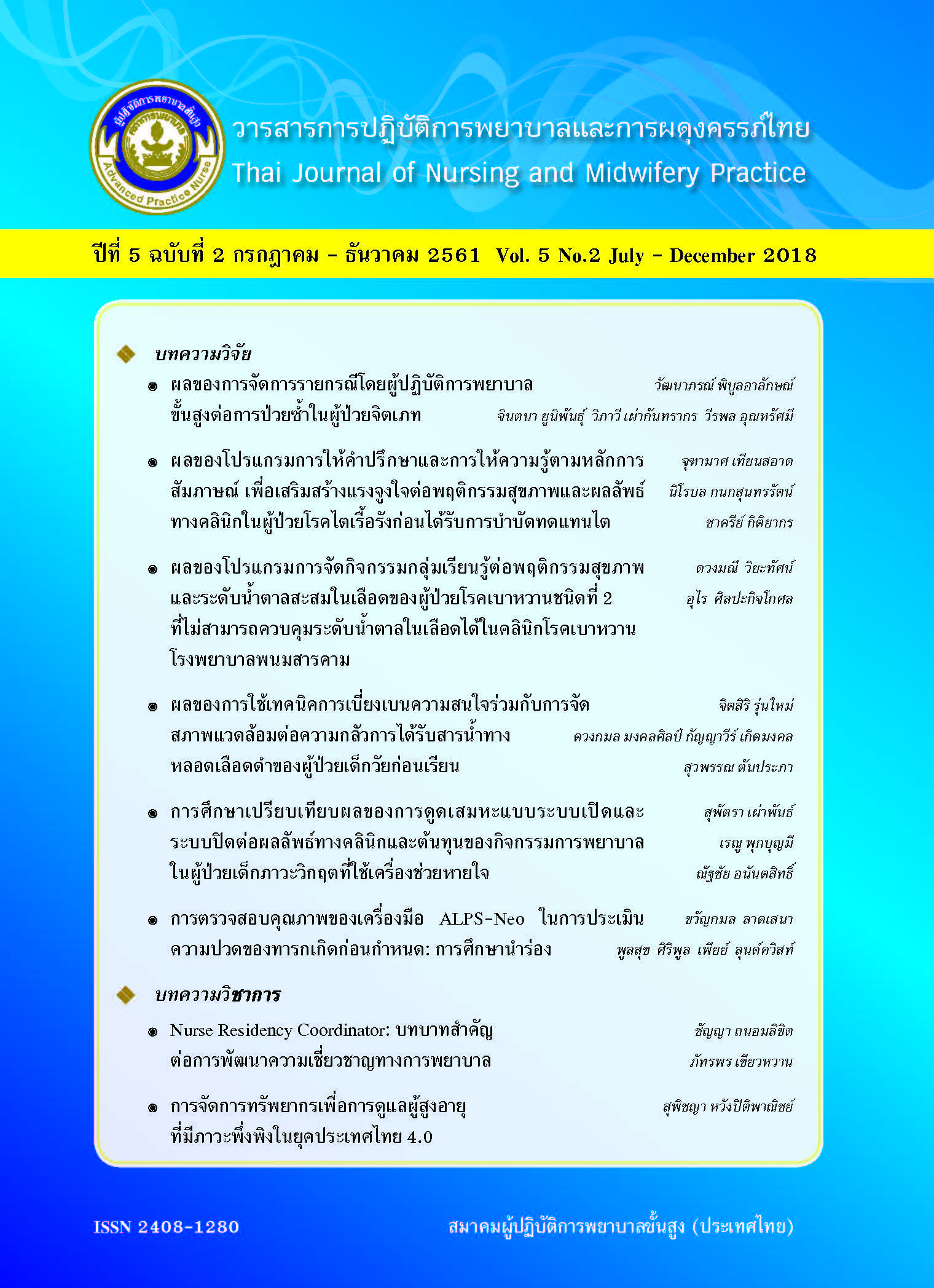Evaluation of ALPS-Neo instrument for assessing pain in premature infants: A Pilot Study
Main Article Content
Abstract
Pain assessment in preterm infants is important because preterm infants cannot communicate through speech. Pain assessment tools for preterm infants with good quality and appropriateness for the service contexts are needed. This study aimed to examine the quality of Astrid Lindgren and Lund Children's Hospitals Pain and Stress Assessment Scale for Preterm and Newborn Infants (ALPS-Neo) in Thai version. The process included back translation and quality assessment of ALPS-Neo tools with content validity using Indexes of Item-Objective Congruence: IOC. Data were analyzed using SPSS. Results showed that the tool had content validity with IOC = 0.80. The reliability of the tool needs to be further evaluated before implementing into practice.
Downloads
Article Details
References
2. Ministry of Public Health (internet). Department of Health Statistics. Health Strategy and Policy Division, Ministry of Public Health, Thailand: Percentages of preterm infants with weight lower than 2,500; 2018[cited August 14, 2018]. From: https://hdcservice.moph.go.th/hdc/reports.
3. Anand KJS, Phil D, Hickey PR. Pain and its effects in the human neonate and fetus. The New England Journal of Medicine 1987; 317: 1321-1329.
4. Ranger M, Grunau RE. Early repetitive pain in preterm infants in relation to the developing brain. Pain management 2014; 4(1): 57-67.
5. Fabrizi L, Slater R, Worley A, Meek J, Boyd S, Olhede S, Fitzgerald M. A Shift in Sensory Processing that Enables the Developing Human Brain to Discriminate Touch from Pain. Current biology 2011; 21(18): 1552-1558.
6. Fitzgerald M, Walker SM. Infant pain management: a developmental neurobiological approach. Nat Clin Pract Neurol 2009; 5: 35–50.
7. Anand K. J. Pain assessment in preterm neonates. Pediatrics 2007; 119(3): 605-607.
8. Carbajal R, Rousset A, Danan C, Coquery S, Nolent P, Ducrocq S, et al. Epidemiology and treatment of painful procedures in neonates in intensive care units. JAMA 2008; 300 (1): 60–70.
9. McKay RJ. Diagnosis and treatment: risks of obtaining samples of venous blood in infants. Pediatrics 1966; 38: 906-8.
10. Seymour E, Fuller BF, Pedersen-Gallegos L, Schwaninger JE. Modes of Thought, Feeling, and Action in Infant Pain Assessment by Pediatric Nurses. Journal of Pediatric Nursing 1997; 12 (1): 32-50.
11. Porter F L, Wolf CM, Miller JP. Procedural pain in newborn infants: The influence of intensity and development. Pediatrics 1999; 104(1).
12. Macintyre PE, Schug SA, Scott DA, Visser EJ, & Walker SM. Working Group of the Australian and New Zealand College of Anaesthetists and Faculty of Pain Medicine, Acute Pain Management: Assessment and measurement of pain. (3rd edition). Melbourne: ANZCA & FPM; 2010.
13. Ongiem A, Vichitvejpaisal P. Validation of the Tests. Thai J Anesthesiol 2018; 44(1): 36-42.
14. Boyle EM, Freer Y, Wong CM, McIntosh N, Anand KJS. Assessment of persistent pain or distress and adequacy of analgesia in preterm ventilated infants. Pain 2006; 124: 87-91.
15. Pillai Riddell RR, Stevens BJ, McKeever P, Gibbins S, Asztalos L, Katz J, et al. Chronic pain in hospitalized infants: health professionals' perspectives. J Pain 2009; 10: 1217-25.
16. Pillai Riddell R, Fitzgerald M, Slater R, Stevens B, Johnston C, Campbell-Yeo M. Using only behaviours to assess infant pain: a painful compromise. Pain 2016; 157: 1579-80.
17. Van GCJ, Anand KJS, Kramer BW, Andriessen P. Chronic pain in the newborn: toward a definition. Clin J Pain 2014; 30: 970-7.
18. Vinall J, Grunau RE. Impact of repeated procedural pain-related stress in infants born very preterm. Pediatr Res 2014; 75: 584-7.
19. Lundqvist P, Kleberg A, Edberg A, Larsson BA, Hellstrom- Westas L, Norman E. Development and psychometric properties of the Swedish ALPS-Neo pain and stress assessment scale for newborn infants. Acta Peadiatrica 2014; 103: 833–839.
20. Nosherwan A, Kumaran K, Tyebkhan MJ. Neurobehavioural Disorganisation (NBD) as a result of Targeted Neonatal Echocardiography (TNE) in extremely preterm infants – a pilot study. 28th Annual NIDCAP Trainers Meeting, Edmonton, Alberta, Canada, October 21–24, 2017 October; 21–24.
21. Jabraeili1 M, Eskandari S, Hosseini MB, Rahmani P, The Effect of Body Position on Pain Due to Nasal Continuous Positive Airway Pressure (CPAP) in Premature Neonates: A Cross-Over Clinical Trial Study. Int J Pediatr 2017; 6(1): 6861-71.
22. Ceylan SS, Bolisik B. Validity and reliability of ALPS-Neo pain and stress assessment scale in newborns. Pamukkale Tıp Dergisi 2017; 10(1): 45-52.
23. Anand KJS, Eriksson M, Boyle EM, Avila-Alvarez A, Dovland AR, Sarafidis K, et.at. Assessment of continuous pain in newborns admitted to NICUs in 18 European countries. Acta Pædiatrica 2017; 106: 1248–1259.
24. Holsti L, Grunau RE, Oberlander TF, Whitfield MF. Specific Newborn Individualized Developmental Care and Assessment Program Movements Are Associated With Acute Pain in Preterm Infants in the Neonatal Intensive Care Unit. PEDIATRICS 2004; 114 (1): 65-72.
25. Brislin RW. Back-translation for cross-culturalresearch. J Cross-Cult Psychol 1970; 1(3): 185-216.
26. Rask M, Oscarsson M, Ludwig N, Swahnberg K. The Swedish translation and cross- cultural adaptation of the Functional Assessment of Chronic Illness Therapy – Cervical Dysplasia (FACIT-CD): linguistic validity and reliability of the Swedish version. BMC Women's Health 2017; 17:24.


